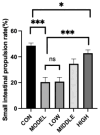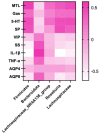Oat Fiber Alleviates Loperamide-Induced Constipation in Mice by Modulating Intestinal Barrier Function
- PMID: 40806066
- PMCID: PMC12348296
- DOI: 10.3390/nu17152481
Oat Fiber Alleviates Loperamide-Induced Constipation in Mice by Modulating Intestinal Barrier Function
Abstract
Objective: To investigate the effects of oat fiber on animal constipation and elucidate its underlying mechanisms. Methods: Male BALB/c mice were randomly allocated into five groups: control group (CON), model control group (MODEL), low dose group (LOW), middle dose group (MIDDLE), high dose group (HIGH). Constipation was induced in the mice by intragastric administration of loperamide. Subsequently, the mice (except those in the CON and MODEL groups) were administered oat fiber intragastrically for 21 consecutive days. Results: Compared with the MODEL group, oat fiber significantly increased the number of fecal pellets, fecal wet weight, and fecal water content (p < 0.05), shortened the time to first black stool excretion (p < 0.05), and enhanced the small intestinal propulsion rate in constipated mice. Additionally, oat fiber significantly upregulated motilin (MTL) and gastrin (GAS) levels (p < 0.05), while downregulating vasoactive intestinal peptide (VIP) and somatostatin (SS) levels (p < 0.05). It also significantly reduced the transcription level of Aquaporin 8 (AQP8) (p < 0.05), effectively alleviating intestinal mucosal injury and immune inflammation. The relative expression levels of TNF-α and IL-1β were significantly decreased in the oat fiber group (p < 0.05). Gut microbiota analysis revealed that oat fiber increased both the abundance and diversity of gut microbiota in constipated mice. Specifically, oat fiber was found to enhance the relative abundance of Firmicutes while reducing that of Bacteroidetes. At the genus level, it promoted the proliferation of Lachnospiraceae_NK4A136_group and Roseburia. Conclusions: Oat fiber alleviates constipation in mice by modulating gastrointestinal regulatory peptides, gut microbiota, aquaporin and mitigating intestinal barrier damage and immune-inflammatory responses.
Keywords: constipation; gastrointestinal regulatory peptides; gut microbiota; immune inflammatory response; oat fiber.
Conflict of interest statement
Author Ligang Yang has received research grants from BYHEALTH Institute of Nutrition & Health. Authors Di Wang and Zhongxia Li are employed BYHEALTH Institute of Nutrition & Health. And the funding agency had no role in the design, execution, or interpretation of the study. The authors declare no conflicts of interest.
Figures












Similar articles
-
Study on the effects of the atractylodes macrocephala koidz-raphanus sativus l herb pair in alleviating senile constipation via the gut microbiota-SCFAs-5-HT axis.Phytomedicine. 2025 Sep;145:156977. doi: 10.1016/j.phymed.2025.156977. Epub 2025 Jun 14. Phytomedicine. 2025. PMID: 40554896
-
Milk fermented by combined starter cultures comprising three Lactobacillus strains exerts an alleviating effect on loperamide-induced constipation in BALB/c mice.Food Funct. 2023 Jun 6;14(11):5264-5276. doi: 10.1039/d3fo00222e. Food Funct. 2023. PMID: 37194317
-
2'-Fucosyllactose synbiotics with Bifidobacterium bifidum to improve intestinal transcriptional function and gut microbiota in constipated mice.Food Res Int. 2025 Oct;217:116840. doi: 10.1016/j.foodres.2025.116840. Epub 2025 Jun 9. Food Res Int. 2025. PMID: 40597542
-
Effects and mechanisms of nuciferine on constipation through regulation of the SCF/c-Kit/NF-κB/TLR4 signaling pathway in STC model mice.J Nutr Biochem. 2025 Jul 29;146:110045. doi: 10.1016/j.jnutbio.2025.110045. Online ahead of print. J Nutr Biochem. 2025. PMID: 40744285
-
β-Sitosterol protects against food allergic response in BALB/c mice by regulating the intestinal barrier function and reconstructing the gut microbiota structure.Food Funct. 2023 May 22;14(10):4456-4469. doi: 10.1039/d3fo00772c. Food Funct. 2023. PMID: 37066493 Review.
References
-
- Corsetti M., Brown S., Chiarioni G., Dimidi E., Dudding T., Emmanuel A., Fox M., Ford A.C., Giordano P., Grossi U., et al. Chronic Constipation in Adults: Contemporary Perspectives and Clinical Challenges. 2: Conservative, Behavioural, Medical and Surgical Treatment. Neurogastroenterol. Motil. 2021;33:e14070. doi: 10.1111/nmo.14070. - DOI - PubMed
MeSH terms
Substances
Grants and funding
LinkOut - more resources
Full Text Sources
Medical

